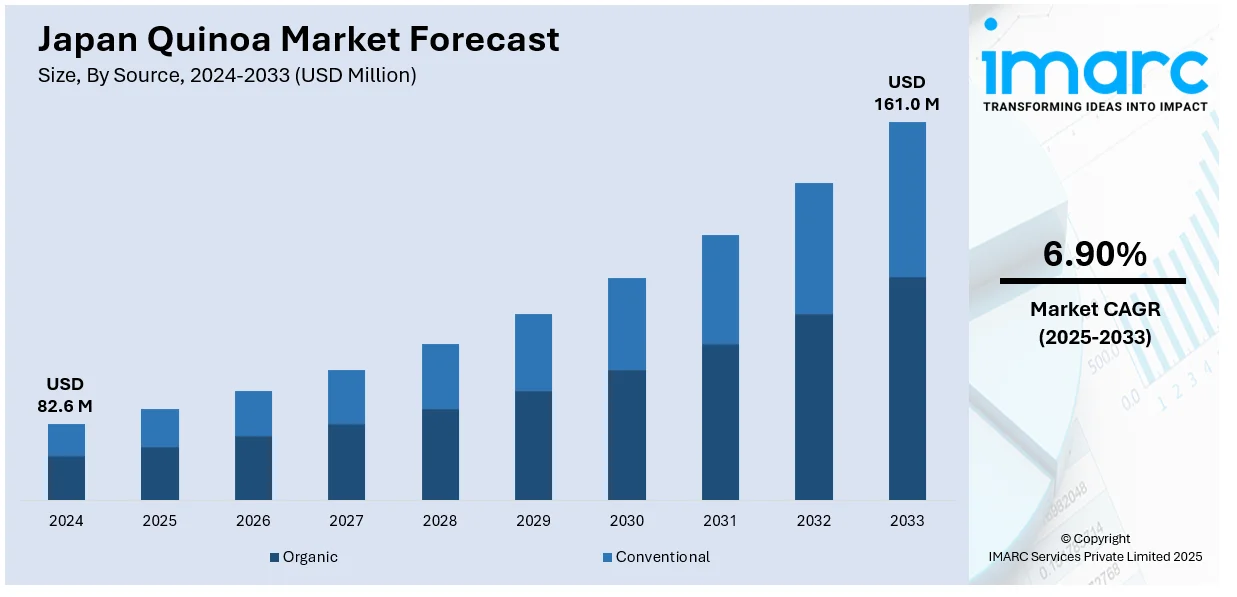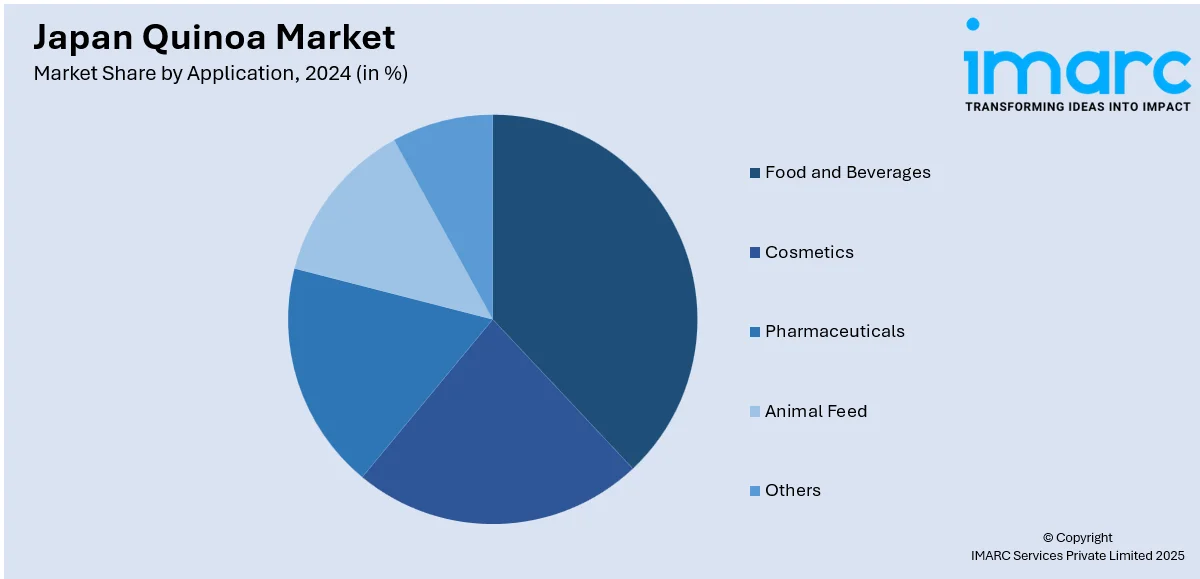
Japan Quinoa Market Size, Share, Trends and Forecast by Source, Product Type, Application, Distribution Channel, End Use, and Region, 2025-2033
Japan Quinoa Market Overview:
The Japan quinoa market size reached USD 82.6 Million in 2024. Looking forward, IMARC Group expects the market to reach USD 161.0 Million by 2033, exhibiting a growth rate (CAGR) of 6.90% during 2025-2033. The market is experiencing robust growth driven by increasing health consciousness, rising adoption of plant-based diets and growing awareness about quinoa's nutritional benefits. Moreover, enhanced retail distribution including supermarkets and online platforms, is also driving the market growth.
|
Report Attribute
|
Key Statistics
|
|---|---|
|
Base Year
|
2024 |
|
Forecast Years
|
2025-2033
|
|
Historical Years
|
2019-2024
|
| Market Size in 2024 | USD 82.6 Million |
| Market Forecast in 2033 | USD 161.0 Million |
| Market Growth Rate 2025-2033 | 6.90% |
Japan Quinoa Market Trends:
Rising Health Consciousness
As Japanese consumers become more health-conscious there is growing interest in quinoa due to its high protein levels, gluten-free status and remarkable nutrient profile. Quinoa has often been termed a "superfood" and provides the essential amino acids, vitamins and minerals that assist in developing a balanced and healthy diet. Its adaptability enables it to be incorporated into a variety of meals ranging from salads and soups to sushi and rice bowls making it a desirable alternative to traditional grains such as rice. Additionally, the growth in fitness and increased emphasis on weight management and gut health are encouraging increasing numbers of consumers to opt for quinoa as a healthier food choice. This trend is congruent with Japan's general transition towards healthier dietary practices further increasing the demand for quinoa. With growing awareness and consumer interest, the Japan quinoa market outlook is expected to remain positive in the coming years.

Growth in Plant-Based Diets
As plant-based diets gain popularity in Japan increasingly more consumers look for high-quality plant-based protein sources like quinoa. The increasing perception of the health and environmental advantages of reducing animal product intake is driving this trend. Quinoa with its complete protein profile is becoming more and more a staple of vegan and vegetarian diets because it has all nine of the essential amino acids and is a perfect meat and dairy product substitute. Furthermore, as more foodservice establishments and retailers provide plant-based foods quinoa is now being added to many products like plant-based burgers, bowls and snacks. The growth of veganism and vegetarianism specifically among the young and health-conscious people directly is fueling the demand for quinoa. Quinoa’s versatility and nutritional benefits make it a popular choice, and this trend is contributing positively to the Japan quinoa market growth. As the market diversifies and expands, quinoa's popularity is likely to continue rising.
Rising Availability in Retail Channels
Quinoa's expanding popularity in Japan is directly related to its greater availability in retail channels. Supermarkets, health food stores and internet sites are increasingly stocking quinoa making it more widely available to consumers. Retailers are adding to their product lines not only quinoa seeds but also ready-to-eat meals, snacks and other convenience foods made from quinoa reflecting the demand for convenient and healthy foods. The ease of buying quinoa in traditional stores and online stores makes the product accessible to health-aware consumers to easily include in their diets. While quinoa becomes ubiquitous in Japanese homes its mainstream retail presence continues to expand to reach a wider audience. The product’s presence is also supported by increased awareness through marketing and promotions in retail spaces. As more brands offer quinoa-based products and consumers become more familiar with its benefits the demand for quinoa will only continue to grow. This rising availability is a crucial factor in driving Japan quinoa market share further solidifying its position in the country’s healthy eating trends.
Japan Quinoa Market Segmentation:
IMARC Group provides an analysis of the key trends in each segment of the market, along with forecasts at the country and regional levels for 2025-2033. Our report has categorized the market based on source, product type, application, distribution channel, and end use.
Source Insights:
- Organic
- Conventional
The report has provided a detailed breakup and analysis of the market based on the source. This includes organic and conventional.
Product Type Insights:
- Red Quinoa
- Black Quinoa
- White Quinoa
- Others
A detailed breakup and analysis of the market based on the product type have also been provided in the report. This includes red quinoa, black quinoa, white quinoa, and others.
Application Insights:

- Food and Beverages
- Cosmetics
- Pharmaceuticals
- Animal Feed
- Others
A detailed breakup and analysis of the market based on the application have also been provided in the report. This includes food and beverages, cosmetics, pharmaceuticals, animal feed, and others.
Distribution Channel Insights:
- Supermarkets and Hypermarkets
- Traditional Retail Stores
- Convenience Stores
- Online
- Others
A detailed breakup and analysis of the market based on the distribution channel have also been provided in the report. This includes supermarkets and hypermarkets, traditional retail stores, convenience stores, online, and others.
End Use Insights:
- Ingredient
- Packaged Food
A detailed breakup and analysis of the market based on the end use have also been provided in the report. This includes ingredient and packaged food.
Regional Insights:
- Kanto Region
- Kansai/Kinki Region
- Central/Chubu Region
- Kyushu-Okinawa Region
- Tohoku Region
- Chugoku Region
- Hokkaido Region
- Shikoku Region
The report has also provided a comprehensive analysis of all the major regional markets, which include Kanto Region, Kansai/Kinki Region, Central/Chubu Region, Kyushu-Okinawa Region, Tohoku Region, Chugoku Region, Hokkaido Region and Shikoku Region.
Competitive Landscape:
The market research report has also provided a comprehensive analysis of the competitive landscape. Competitive analysis such as market structure, key player positioning, top winning strategies, competitive dashboard, and company evaluation quadrant has been covered in the report. Also, detailed profiles of all major companies have been provided.
Japan Quinoa Market Report Coverage:
| Report Features | Details |
|---|---|
| Base Year of the Analysis | 2024 |
| Historical Period | 2019-2024 |
| Forecast Period | 2025-2033 |
| Units | Million USD |
| Scope of the Report |
Exploration of Historical Trends and Market Outlook, Industry Catalysts and Challenges, Segment-Wise Historical and Future Market Assessment:
|
| Sources Covered | Organic, Conventional |
| Product Types Covered | Red Quinoa, Black Quinoa, White Quinoa, Others |
| Applications Covered | Food and Beverages, Cosmetics, Pharmaceuticals, Animal Feed, Others |
| Distribution Channels Covered | Supermarkets and Hypermarkets, Traditional Retail Stores, Convenience Stores, Online, Others |
| End Uses Covered | Ingredient, Packaged Food |
| Regions Covered | Kanto Region, Kansai/Kinki Region, Central/Chubu Region, Kyushu-Okinawa Region, Tohoku Region, Chugoku Region, Hokkaido Region, Shikoku Region |
| Customization Scope | 10% Free Customization |
| Post-Sale Analyst Support | 10-12 Weeks |
| Delivery Format | PDF and Excel through Email (We can also provide the editable version of the report in PPT/Word format on special request) |
Key Questions Answered in This Report:
- How has the Japan quinoa market performed so far and how will it perform in the coming years?
- What is the breakup of the Japan quinoa market on the basis of source?
- What is the breakup of the Japan quinoa market on the basis of product type?
- What is the breakup of the Japan quinoa market on the basis of application?
- What is the breakup of the Japan quinoa market on the basis of distribution channel?
- What is the breakup of the Japan quinoa market on the basis of end use?
- What is the breakup of the Japan quinoa market on the basis of region?
- What are the various stages in the value chain of the Japan quinoa market?
- What are the key driving factors and challenges in the Japan quinoa market?
- What is the structure of the Japan quinoa market and who are the key players?
- What is the degree of competition in the Japan quinoa market?
Key Benefits for Stakeholders:
- IMARC’s industry report offers a comprehensive quantitative analysis of various market segments, historical and current market trends, market forecasts, and dynamics of the Japan quinoa market from 2019-2033.
- The research report provides the latest information on the market drivers, challenges, and opportunities in the Japan quinoa market.
- Porter's five forces analysis assist stakeholders in assessing the impact of new entrants, competitive rivalry, supplier power, buyer power, and the threat of substitution. It helps stakeholders to analyze the level of competition within the Japan quinoa industry and its attractiveness.
- Competitive landscape allows stakeholders to understand their competitive environment and provides an insight into the current positions of key players in the market.
Need more help?
- Speak to our experienced analysts for insights on the current market scenarios.
- Include additional segments and countries to customize the report as per your requirement.
- Gain an unparalleled competitive advantage in your domain by understanding how to utilize the report and positively impacting your operations and revenue.
- For further assistance, please connect with our analysts.
 Request Customization
Request Customization
 Speak to an Analyst
Speak to an Analyst
 Request Brochure
Request Brochure
 Inquire Before Buying
Inquire Before Buying




.webp)




.webp)












